- Home |
- Why With Us |
- About Us |
- Booking |
- Contact Us |
- Site Map
- Home
-
Nepal
-
Trekking
- Arun Valley with Gokyo Lakes
- Everest Base Camp Trek
- Everest- A Living Culture Exploration
- Everest Explore
- Everest Base Camp (via Thame) Trek
- Everest Base Camp with Kala Patthar
- Everest Comfort Trek
- Everest High Passes with Ama Dablam Base Camp
- Everest Mani Rimdu Festival Trek
- Everest Nagpa La Trek
- Everest with three high passes
- Gokyo Ri, Chola Pass & Chukung Ri with Kala Patthar
- Gokyo with Everest Base Camp
- Jomsom - Muktinath
- Jomsom - Muktinath
- Khayar Lake Trek
- Manaslu and Tsum Valley with Larkya La
- Upper Mustang Trek
- Manaslu High Circuit
- Manaslu, Tilicho Pass & Upper Mustang
- Annapurna Base Camp Trek
- The Annapurna Circuit Trek
- Annapurna Panorama
- Nar and Phu Valley Trekking
- Nepal Rhododendron Trek
- Royal Trek
- Saribung Trek and Expedition
- Annapurna Sanctuary Trek
- The Annapurna Sunrise Trek
- Expedition
-
Rafting
-
Peak Climbing
-
Tours
- Kathmandu-Chitwan-Jungle Tour with visit to Pokhara
- Dawn to Dusk Tour
- Historical, Natural & Cultural Tour with Camping
- Kathmandu Valley Temple Tour
- Temple - Panorama - Jungle Tour
- Taste of Nepal
- Central Nepal Tour
- Explore Nepal Tour & Trek
- Nepal Cross-country Tour
- Best of Nepal Tour & Treks
- Kathmandu valley rim Tour & Treks
- Nepal Culture Tour
- Introduction to Nepal Tour & Treks
- Nepal at a glance Tour & Treks
- Wonders of Nepal Tour & Treks
- Glimpses of Nepal Tour & Treks
- Through the Silhouette Tour & Treks
- Tent and Temple Tour
- Kathmandu-Chitwan-Pokhara Tour
- Historical, Cultural City and Jungle Tour
- Nepal Wildlife Tour
- Nepal Panorama Historical Tour
- Nepal Adventure Tour
- Nepal Pilgrimage Tour
- Ghalegaun-Ghanapokhara Homestay Tour
- Jungle Safari
- Adventure Sports
-
Trekking
- Tibet
-
Bhutan
-
India
- Yoga Tour
- About Us
-
The Great Himalayan Trail
-
Short Tours/Treks

Mani Rimdu festival - Everest Region
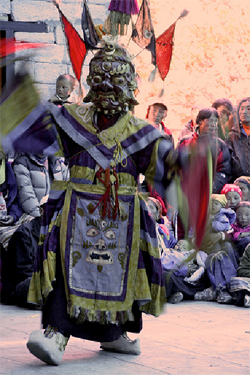 Every year during the month of Oct-Nov, in the Khumbu region of Nepal there occurs a famous Sherpa festival known as Mani Rimdu. This is basically a Buddhist Dance Drama festival, enacted by the monks of Tengboche(Tengboche gompa is home to around 36 monks and 25 students) and Chiwong Monastery simultaneously. The site of this high altitude entertainment is usually the temple or gompa within the monastery compound itself where the Buddhist monks dress in costumes and perform ritual dances invoking Guru Rimpoche and the times he brought the teaching of Buddha to Tibet in the 7th century. Situated on a generous plateau at an altitude of almost four thousand meters, the Tengboche and Chiwong gompas (monastery) are crowned by some of the highest mountains in the world: Thamserku (6608m), Kangteigh (6779m), Taboche (6542m), and of course, the summit of Mt. Everest (8848m) peering above the Lhotse-Nuptse wall.
Every year during the month of Oct-Nov, in the Khumbu region of Nepal there occurs a famous Sherpa festival known as Mani Rimdu. This is basically a Buddhist Dance Drama festival, enacted by the monks of Tengboche(Tengboche gompa is home to around 36 monks and 25 students) and Chiwong Monastery simultaneously. The site of this high altitude entertainment is usually the temple or gompa within the monastery compound itself where the Buddhist monks dress in costumes and perform ritual dances invoking Guru Rimpoche and the times he brought the teaching of Buddha to Tibet in the 7th century. Situated on a generous plateau at an altitude of almost four thousand meters, the Tengboche and Chiwong gompas (monastery) are crowned by some of the highest mountains in the world: Thamserku (6608m), Kangteigh (6779m), Taboche (6542m), and of course, the summit of Mt. Everest (8848m) peering above the Lhotse-Nuptse wall.
The festival of Mani Rimdu is a 19 day sequence of sacred ceremonies and empowerments, culminating in a 3 day public festival. The festival recreates the legendary events in their region, namely the establishment of Buddhism by the great saint Guru Rimpoche who goes by a number of names, such as Padmasambaba, Dorje Trollo and others. Through the dance, symbolic demons are conquered, dispelled, or converted to Dharma protectors, as positive forces clash with those of chaos. The dances are meant to convey Buddhist teachings on many levels – from the simplest to the most profound- and especially for those who do not have the opportunity to study and to meditate extensively. From the beginning until the end of the festival, 24 hour pooja (rituals) are performed by the monks to consecrate the Mandala, the mani Rilwu (sacred pills), the Tsheree (pills of long life) and the Torma. The monks, who perform the dances, first take vows at an empowerment ceremony with the Rinpoche. During the dances they become deities, rather than ordinary people. Because the dances are regarded as sacred, they can only be performed in the context of Mani Rimdu, and not for ordinary entertainment.
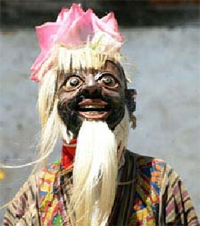 Performed in the lap of these gigantic Himalayan monasteries, the annual long life festival takes three days to complete with the atmosphere culminating to dances, blessing and in the final fire purification built over a sand mandals. This is also the time when the Sherpa in the area take a break from framing and see something akin to a passion play from Europe or the Americas. The dancers convey concepts without writing for much of the population still cannot read or write. Not to mention the fact that there is little prospects for entertainment high in those misty Himalayas. It is therefore an opportunity local Sherpa and Tibetan community, to gather and celebrate together with the monastic community.
Performed in the lap of these gigantic Himalayan monasteries, the annual long life festival takes three days to complete with the atmosphere culminating to dances, blessing and in the final fire purification built over a sand mandals. This is also the time when the Sherpa in the area take a break from framing and see something akin to a passion play from Europe or the Americas. The dancers convey concepts without writing for much of the population still cannot read or write. Not to mention the fact that there is little prospects for entertainment high in those misty Himalayas. It is therefore an opportunity local Sherpa and Tibetan community, to gather and celebrate together with the monastic community.
Mani Rimdu is a re-creation of legendary events; the establishment of Buddhism in Tibet by the great saint, Guru Rinpoche (Padmasambhava). Through the dances, symbolic demons are conquered, dispelled, or converted to Dharma Protectors, as positive forces clash with those of chaos. The dances convey Buddhist teachings on many levels - from the simplest to the most profound - for those who do not have the opportunity to study and meditate extensively.
Major highlights of Mani Rimdu Festival:
Festival Preparations:
Mani Rimdu takes place from the first day of the tenth month of the Tibetan lunar calendar, falling between mid-October and mid-November. It lasts until the nineteenth day of the month. From the beginning until the end of the festival, 24-hour puja's (rituals) are performed by the monks to consecrate the Mandala, the Mani Rilwu Pills (sacred pills), the Tshereel (pills for long life) and the Torma.
The sand Mandala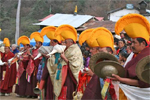 The Mandala is carefully constructed, grain by grain, from colored sand; an intricate and symbolic design that takes many days to complete. Protective dagger deities are placed around the Mandala, and the bowl of Mani Rilwu pills (spiritual medicine) is placed above the center. The Mandala becomes the palace of Garwang Thoze Chenpo, the Lord of the Dance; an emanation of the Buddha of Compassion, and the central deity of Mani Rimdu. The mantra "OM AH HUNG RHI, OM MANI PADME HUMG", is repeated thousands of times by the monks during the weeks of ceremony preceeding the public festival. During their meditation, they visualize compassion flowing in the form of the mantra, into the Mandala and the Mani Rilwu pills. Compassion then radiates out from the Mandala, blessing all those who attend the Mani Rimdu festival.
The Mandala is carefully constructed, grain by grain, from colored sand; an intricate and symbolic design that takes many days to complete. Protective dagger deities are placed around the Mandala, and the bowl of Mani Rilwu pills (spiritual medicine) is placed above the center. The Mandala becomes the palace of Garwang Thoze Chenpo, the Lord of the Dance; an emanation of the Buddha of Compassion, and the central deity of Mani Rimdu. The mantra "OM AH HUNG RHI, OM MANI PADME HUMG", is repeated thousands of times by the monks during the weeks of ceremony preceeding the public festival. During their meditation, they visualize compassion flowing in the form of the mantra, into the Mandala and the Mani Rilwu pills. Compassion then radiates out from the Mandala, blessing all those who attend the Mani Rimdu festival.
The Empowerment (Wong)
The Wong is the opening public ceremony. It’s performed on the full moon day, of the tenth month in the Tibetan lunar calendar. During the ceremony the Rimpoche gives the empowerment on this auspicious occasion, for long life, happiness and prosperity. The sacred Mani Rilwu (sacred pills) and Tshereel (pills for long life), are given to the audience attending the ceremony.
The Dance (Chham)
The dances takes place on the 2nd day of Mani Rimdu
Ser –Kyem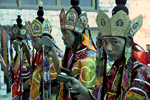 This offering of spiritual nectar is made in many ceremonies. The six dancers represent Ngag-pa, Tantric magicians. They make offerings of alcohol from silver chalices, and small tormas, to the Lama Yidam, Khandro and Shi – Dak (what is known as the earth deities). A Buddhist practitioner takes ‘refuge’ in the lama (spiritual guide), Yidam (personal deity) and Khandro (wisdom dakini). A central theme in Tibetan Buddhism practice is to make offering to these beings so that they will help with the4 virtuous actions which lead to Buddhahood.
This offering of spiritual nectar is made in many ceremonies. The six dancers represent Ngag-pa, Tantric magicians. They make offerings of alcohol from silver chalices, and small tormas, to the Lama Yidam, Khandro and Shi – Dak (what is known as the earth deities). A Buddhist practitioner takes ‘refuge’ in the lama (spiritual guide), Yidam (personal deity) and Khandro (wisdom dakini). A central theme in Tibetan Buddhism practice is to make offering to these beings so that they will help with the4 virtuous actions which lead to Buddhahood.
The Fire Puja (Jinsak)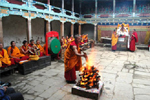 The fire puja is performed in the courtyard the day after the dances. Most of the village people have gone home, and Chiwong will have a quite, almost family atmosphere. The fire puja is an offering to Agni (the God of Fire) and to the Gods of the mandala – to allay all harm in the world. The harm is visualized as dissolving into the grain and butter is burned. Afterwards, the sand mandala in the temple is dismantled, and the sand is given as an offering to the serpent gods (Nagas) at the spring below the monastery.
The fire puja is performed in the courtyard the day after the dances. Most of the village people have gone home, and Chiwong will have a quite, almost family atmosphere. The fire puja is an offering to Agni (the God of Fire) and to the Gods of the mandala – to allay all harm in the world. The harm is visualized as dissolving into the grain and butter is burned. Afterwards, the sand mandala in the temple is dismantled, and the sand is given as an offering to the serpent gods (Nagas) at the spring below the monastery.
Chhingpa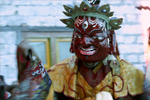 The next dance depicts the four protecting Ghings, defending the Buddhist faith against attack by demons. Shining paper masks hide the faces of the dancers, each a different colours and each displaying a constant smile accompanied by the beating of cymbals. Without breaking step, the dancers charger haltingly at children in the audience. The youngsters recoil in horror, much to the amusements of everyone in the audience. The gentle dance of the Dakini contrasts sharply with what has gone previously. Five young priests execute slow motion dance steps, keeping perfect time with the soft tinkle and slow beat of bells and drums held in their hands. The dance3rs are without masks, and portray female spiritual figures, the partners of Padmasambhave who has come from the pure land of Shangdok Palri where they live within his mandals. They herald the imminent arrival of Guru Rimpochhe at the Mani Rimdu. Two of the Ghing are male, and carry cymbals, while the two females carry drums. The makes represent skillful means and the female represent wisdom; these two aspects of the path to enlightenment are at the heart of Vajrayana (tantric) practice. The union and harmony of skillful means (compassion) and wisdom, is often depicted (and often misunderstoond) in Tantric iconography.
The next dance depicts the four protecting Ghings, defending the Buddhist faith against attack by demons. Shining paper masks hide the faces of the dancers, each a different colours and each displaying a constant smile accompanied by the beating of cymbals. Without breaking step, the dancers charger haltingly at children in the audience. The youngsters recoil in horror, much to the amusements of everyone in the audience. The gentle dance of the Dakini contrasts sharply with what has gone previously. Five young priests execute slow motion dance steps, keeping perfect time with the soft tinkle and slow beat of bells and drums held in their hands. The dance3rs are without masks, and portray female spiritual figures, the partners of Padmasambhave who has come from the pure land of Shangdok Palri where they live within his mandals. They herald the imminent arrival of Guru Rimpochhe at the Mani Rimdu. Two of the Ghing are male, and carry cymbals, while the two females carry drums. The makes represent skillful means and the female represent wisdom; these two aspects of the path to enlightenment are at the heart of Vajrayana (tantric) practice. The union and harmony of skillful means (compassion) and wisdom, is often depicted (and often misunderstoond) in Tantric iconography.

- History
- Overview
- Ancient Nepal
- The Early Kingdom of the Licchavis
- Medieval Nepal, 750-1750
- The Malla Kings
- The Three Kingdoms
- The Making of Modern Nepal
- The Struggle for Power
- The Enclosing of Nepal
- Infighting among Aristocratic Factions
- Rana Rule
- The Ranas
- The Growth of Political Parties
- The Return of the King
- The Democratic Experiment
- The Panchayat System under King Mahendra
- King Birendra
- Movement to restore democracy
- Maoist Insurgency
- Struggle for Democracy
- King's Direct Rule
- People's Movement
- The Constitutional Assembly Election
- Government and Political Conditions
- Geography
- Festivals of Nepal
- Overview
- Bada Dashain (September-October)
- Sri Panchami or Basanta Panchami
- Tihar and Laxmi Puja - festival of lights (Oct-Nov)
- Maghe Sankranti
- Naga Panchami
- Janai Poornima (Rokshya Bandhon)
- Gaijatra
- Pancha Dan
- Teej and Rishi Panchani
- Indrajatra
- Ghanta Karna
- Buddha Jayanti
- Maha Shivaratri
- Phagu Poornima or Holy
- Ghode Jatra
- Chaite Dashain
- Nava Varsha / New Year
- Festival of Seto Machhendranath
- Matatirtha Aunsi or Mother\'s Day
- Bala Chaturdashi
- Sri Krishna Janmastami
- Rama Nawami
- Mani Rimdu festival - Everest Region
- Tiji Festival, Mustang
- Dumje Festival - Everest Region
- Flora and Fauna of Nepal
- Flowering Plants of Nepal
- Getting in to Nepal
- Climate
- Nepal Visa Procedures
- Nepalese Embassies and Consulates Abroad
- Places visit in Nepal
- Orchids of Nepal
- World Heritage Sites of Nepal
Trekking in Nepal
Expeditions In Nepal
Rafting in Nepal
Tours in Nepal
All rights reserved.



